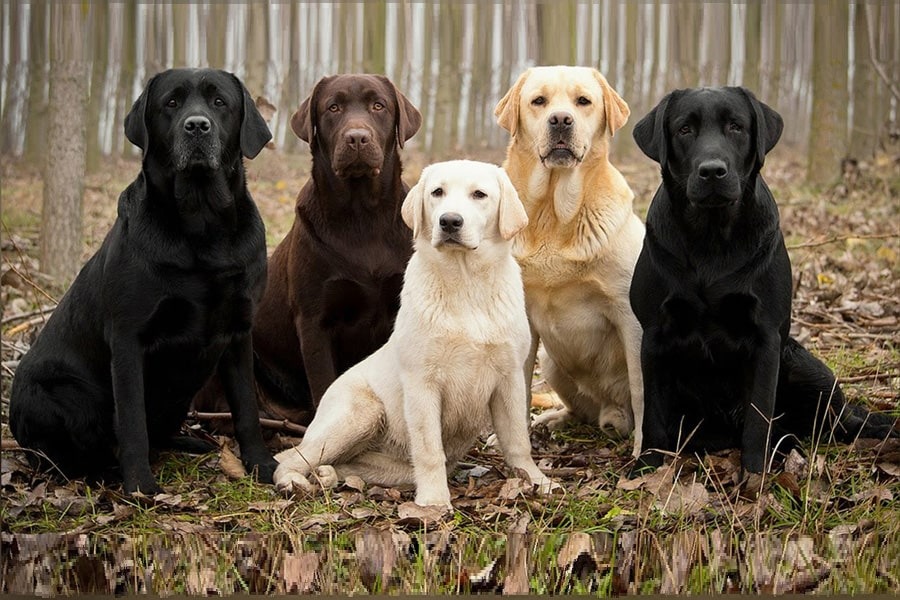Labrador Retrievers are a fantastic breed of dog known for their positive energy and unfaltering devotion. The four-legged embodiment of personality, intellect, and mischief is frequently praised as the ideal family dog. Labrador Retrievers Dogs are the perfect companions for everybody, whether you’re an adventurer in search of a fetching dog or a couch potato in want of a viewing partner for your Netflix marathon. In this blog, Canvas Personalized will discuss every detail about this adorable furry pet. Get ready to jump headfirst into the wonderful world of Labs!
1. Short Facts About Labrador Retriever Dogs

| Origin | Newfoundland, Canada |
| Breed group | sporting |
| Size | Males weigh 65–80 pounds (29–36 kg) Females weigh 55–70 pounds (25–32 kg) |
| Height at withers | 21.5–24.5 inches (55–62 cm) |
| Breed Group | Sporting |
| Lifespan | 10 to 14 years |
| Exercise | 40 minutes/day |
| Energy level | Average |
| Color | Black, yellow, and chocolate |
- Coat: A Labrador Retriever’s genes determine what color its skin will be. The AKC breed standard specifies that the only acceptable colors for Labrador Retrievers are black lab, chocolate lad, and yellow lad. However, some breeders may produce Labradors of other colors, such as white lab, silver lab, or charcoal lab.
- Temperament: friendly, outgoing, with a gentle nature. They are often described as one of the most family-friendly dog breeds, and they are great with children and other pets.
- Exercise Needs: Labrador Retrievers are active dogs and require regular exercise and mental stimulation. They enjoy activities like fetching, swimming, and hiking.
- Training: They are brilliant and trainable, making them one of the most popular choices for working dogs, including search and rescue, therapy, and assistance dogs.
- Grooming: The Labrador Retriever has relatively low grooming needs. Regular brushing and occasional baths are necessary to keep their coats healthy.
- Health: While generally healthy, Labradors can be prone to genetic health issues such as hip and elbow dysplasia and certain eye conditions. Responsible breeding and regular vet check-ups can help reduce these risks.
- Popularity: After a 31-year run as America’s most popular dog breed, Labrador Retriever Dogs lost that title to the French Bulldog in 2023.
2. The History of the Labrador Retriever Dogs

The AKC states that the first Labrador retrievers descended from the rare and aquatic St. John’s water dog in England. The first St. John’s water dogs arrived from Newfoundland and helped fishermen retrieve nets, gear, and fallen fish.
Labrador Retriever Dogs originally served as gun dogs that could retrieve waterfowl. Over time, they evolved into highly skilled sporting dogs, entered the dog show circuit, and finally became the lovable family pets we know today. The Labrador Retriever is still among the most beloved canine varieties globally, particularly in North America.
3. All Information About Labrador Retriever Dogs
3.1. Breed Appearance of Labrador Retrievers

- A Labrador is a big, strong dog with robust bones and a muscular build. They exude an air of friendliness because of their large heads and gentle, intelligent-looking eyes.
- As a consummate water dog, a lab’s webbed toes help them stay comfortable in colder climates, forming a “snowshoe” that keeps snow and ice from getting stuck between their toes. Their tails are described as “otter-like, “strong, and almost constantly wagging.
- Labrador Retriever Dogs‘ colors vary from black and yellow to chocolate, with some dogs sporting different shades and hues.
3.2. Labrador Retriever Characteristics

- It is justifiable to say that Labs are among the friendliest dog breeds.
- Labrador Retriever Dogs have a gregarious personality, are quick to please, and get along well with humans and other animals.
- They are easy to train since they are smart, eager to please, and charming.
- This breed requires training due to its high levels of energy and enthusiasm.
- To be content, this breed needs both mental and physical challenges. Some labs are exceptionally hyperactive, while others prefer to take it easy.
3.3. How to Feed a Labrador Retriever Dogs

- For puppy Labrador Retriever Dogs: They need a diet heavier in fat and protein than adult Labradors. Additionally, carbohydrates are necessary for sustaining your energetic dog. Labrador puppies can get extra protein from raw meat such as lean beef, turkey, chicken, or fish, in addition to nutritionally adequate dry puppy chow.
- For adult Labrador Retriever Dogs: weight, energy, age, and reproductive state determine food intake. Average adult Labradors need 1250 to 1780 calories from high-quality food.
3.4. Hair Care and Grooming for Labrador Retrievers

Of course, you can bathe your Labrador Retriever Dogs more frequently if they get dirty (they typically roll in mud puddles) or if they ingest anything nasty.
- Cleaning their teeth: To keep your lab healthy, brush them twice or thrice a week to remove tartar and bacteria. Cleaning your teeth at least twice a day is recommended to prevent gum disease and bad breath.
- Trim your dog’s nails regularly: If it doesn’t naturally wear down your nails, you should trim them once or twice a month. A well-kept pair of feet with short, well-trimmed nails will keep your lab from rubbing against your legs as it eagerly meets you.
- Cleaning the dog’s ears: inspecting them once a week for any signs of infection, such as redness or a foul odor, is essential. To prevent infections, use a cotton ball wetted with a mild, pH-balanced ear cleaner to wipe out your dog’s ears whenever you examine them.
- Only clean the outside of your ear; never put anything in your ear canal. Drying your dog’s ears thoroughly after swimming, bathing, or any other time he gets wet is essential, as ear infections are prevalent in labs.
- Check their teeth. It would be best to examine their mouths frequently.
- Grooming their coat: when grooming, look for any redness, pain, or swelling on the skin, nose, mouth, eyes, or feet that could indicate an infection. Avoid looking red or having discharge if your eyes aren’t clear. You can catch any health issues by checking yourself every week before they worsen.
3.5. Training Tips For Labrador Retriever Dogs

- This sociable breed is highly responsive to sounds and other forms of positive reinforcement. These large, sociable dogs learn best through vocal encouragement and positive reinforcement because they view life as a game.
- Thanks to their innate sociability, Labrador Retriever Dogs benefit greatly from physical exercise and mental stimulation when allowed to run free in a supervised area with other dogs. To ensure their safety, though, proper recall training is essential.
3.6. Wellness for Labrador Retrievers
Although Labrador Retriever dogs seem healthy, they are susceptible to a few common diseases. Even though not every lab will suffer from the disease on this list, it’s important to know about them if you’re considering this dog breed.

- Hip dysplasia
- Elbow dysplasia
- Osteochondrosis Dissecans (OCD)
- Cataracts
- Progressive Retinal Atrophy (PRA)
- Epilepsy
- Tricuspid Valve Dysplasia (TVD)
- Myopathy
- Bloat, or gastric dilation and volvulus
- Acute Moist Dermatitis
- Cold Tail
- Ear Infections
- Hip dysplasia: is a genetic disorder where the thighbone cannot tightly fit the hip joint. A dog with hip dysplasia may not exhibit discomfort symptoms, although some exhibit pain and lameness on one or both back legs.
- Elbow dysplasia: is a hereditary disorder that disproportionately affects dogs of giant breeds. Joint laxity is the outcome of the three bones comprising a dog’s elbow developing at various rates. The result could be excruciating lameness.
- Osteochondrosis Dissecans (OCD): This orthopedic disorder is typically found in the elbows, although it can also occur in the shoulders. The abnormal cartilage formation of the joints is what causes it. The dog cannot flex his elbow because of the stiffness it produces in his joints. Dogs as young as four to nine months old can be detected with it.
- Cataracts: Like cataracts in people, canine cataracts are characterized by gradually growing foggy spots on the eye’s lens. They can manifest in people of any age. In most cases, surgical removal of cataracts yields satisfactory outcomes.
- Progressive Retinal Atrophy (PRA): Labrador Retriever Dogs will develop night blindness early in this disease. Their ability to see throughout the day also diminishes as the disease advances. If their environment stays the same, many dogs can adjust to having restricted or no vision.
- Epilepsy: Seizures, whether moderate or severe, can occur in labs. Unusual behavior, like hurriedly running as if being followed, staggering, or hiding, can signify a seizure.
- Tricuspid Valve Dysplasia (TVD): A congenital cardiac condition, TVD is becoming more common in Labrador puppies. The tricuspid valve deformity (TVD) affects the right side of the heart and is present at birth in puppies. Some canines experience no symptoms at all, while others succumb to the disease.
- Myopathy: This condition affects the neurological system and muscles. The earliest symptoms often appear between six and seven months of age but can be observed as early as six weeks. When walking or trotting, a puppy suffering from myopathy will appear tired and rigid. After working out, he could pass out. The dog’s ability to stand and walk is severely impaired as a result of muscular atrophy.
- Bloat, or gastric dilation and volvulus: is a potentially fatal illness that can strike big, deep-chested dogs like Labs if they eat quickly, drink a lot of water, or engage in strenuous activity just after eating.
- Acute Moist Dermatitis: This skin ailment causes red and swollen skin. The cause of it is a bacterial infection. This health condition is most commonly known as hot spots. Antibiotics, medicinal shampoo, and hair trimming are all part of the treatment plan.
- Cold Tail: Labs and other retrievers frequently experience this benign but unpleasant ailment. It also made the dog’s tail lean and flexible. Sometimes, dogs may gnaw on their tails. There is nothing to worry about; in most cases, it resolves itself after a few days.
- Ear Infections: Labrador Retriever Dogs are more vulnerable to ear infections because they love water and drop ears. To help avoid disease, check and clean as needed weekly.
3.7. A Labrador Retriever’s Perfect Living

You can’t have Labrador Retriever Dogs without regular walks and playing in the yard. Labs live best in large backyards or other open areas where they can run around and play fetch for hours. These dogs are great for families with lots of energy because of their playful nature and friendly demeanor.
>>> Maybe you’re interested in:
- All Chihuahua Dog Breed Information & Fun Facts To Take Care
- Discovering The Great Dane Dog Breed: A Comprehensive Guide
In conclusion, Canvas Personalized has covered every aspect to make sure you are prepared for the great adventure of having a Labrador as a part of your life, from their kind nature to their intelligent attractiveness. As you start this amazing journey, keep in mind that the real delight of Labradors isn’t in the knowledge you’ve gained, but in the simple moments you get to spend with these wonderful friends. We hope you enjoy your new knowledge and look forward to hearing all the happy stories about Labrador Retriever dogs!










